Archived Mold Remediation Blog Posts
Mold Removal in Commercial Properties: Trusting SERVPRO of East Boston, Chelsea, & Revere
4/26/2023 (Permalink)
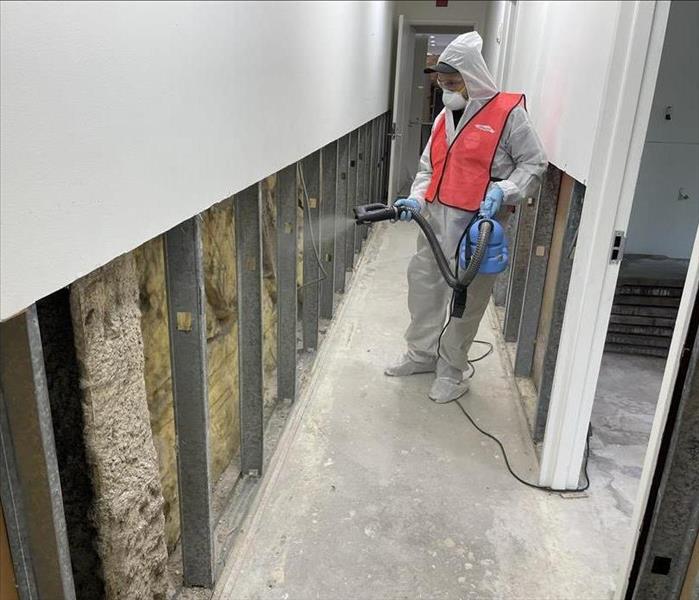 SERVPRO of East Boston, Chelsea, & Revere is an area leader in mold remediation services, call us today to learn more.
SERVPRO of East Boston, Chelsea, & Revere is an area leader in mold remediation services, call us today to learn more.
Mold is a common problem in commercial properties in the Boston, MA area. It can grow quickly in moist and humid environments, and if left untreated, can cause significant damage to the structure of the building and impact the health of the occupants.
That's why it's important to work with a trusted and experienced mold removal company like SERVPRO of East Boston, Chelsea, & Revere. As part of the SERVPRO Team Luzzi network, they have the expertise, equipment, and training to effectively mitigate mold in commercial properties.
Their mold removal process starts with a thorough inspection of the property to determine the extent of the mold growth and the source of moisture. They then use specialized equipment and techniques to contain the mold and prevent it from spreading to other areas of the building. They also use air scrubbers and HEPA vacuums to remove mold spores from the air.
Once the mold has been removed, SERVPRO of East Boston, Chelsea, & Revere will clean and sanitize the affected areas to ensure that all traces of mold have been eliminated. They will also work with the property owner to identify and address any underlying moisture issues to prevent future mold growth.
Overall, if you're dealing with mold in a commercial property in the Boston, MA area, SERVPRO of East Boston, Chelsea, & Revere is an excellent choice for mold mitigation services. Their experience, expertise, and commitment to customer satisfaction make them a leader in the industry.
So you sent the remediation company home early
7/27/2017 (Permalink)
 Look closely.. the wallpaper looks as though it is in good shape. As it peeled away from the wall it revealed the scope of the mold problem.
Look closely.. the wallpaper looks as though it is in good shape. As it peeled away from the wall it revealed the scope of the mold problem.
A home owner or business owner wants to get back to normal as soon as possible. Working to make that happen is our goal. That being said water damage or fire damage is never a pretty thing. The right expectations need to be understood. Beyond that what needs to be understood is the reason for the time frame and process.
Let me explain. All too often especially with water damage issues we are asked to cease and desist. Pack up our stuff and leave before the work is done. There are even times that we recommend opening a wall, or pulling up the floor. Home owners and business owners will refuse to let us to do this sort of work. Why would they do that you ask. There are a number of reasons but the main one is that they do not want the inconvenience of more intrusion into their home. This is always a bad idea.
Restoration companies have extensive training and certifications that most do not. They also have years of experience working with insurance companies and property adjusters. This leads to a great understanding of the scope of work that is needed to properly mitigate your building. This ensures what they call secondary damage is not an option.
First let us get into what secondary damage actually is. Secondary damage is something that would not have happened even if the first occurred. Let me explain. If you do have a pipe break, you call and get the plumber out and stop the water. Moisture damage is what happens when you do not mitigate the water that intruded into your home fast enough.
Some key examples of what is considered secondary damage is when your wood floors start to buckle. This is not from the water intrusion it is from the wood sitting in the water that is underneath . The wood warps. This warping forces the finish to crack and the floors are not salvage able.
Ok so you don’t have wood floors. Vinyl is not much better, look at that edging popping up. That is damage from the water getting under the floor and damaging the glue.
Cracks in sheet rock and sagging ceiling are a result of moisture continuing to collect if they did not have an outlet to release the water.
Mold colonization. This is probably the most problematic. The challenge here is many times it will be somewhere you cannot see until it is a real problem. Similar to an iceberg you only see a fraction what is there. Lurking behind a wall under a floor or even where you see nothing at all such as in a duct system.
Let us get back to the reason for this post. We have clients that ask us to leave early and no explanation in the world is going to change their minds. Business owners are looking at the short term issue they have to be closed. Closing means so money is coming in and many do not have the proper insurance to cover loss of business. Additionally they tend to have very high deductibles or inadequate coverage. Coupled with lack of income there are a lot of bad decision made. They only want the visible water dried out. They will not allow demolition to occur for it will delay the process of reopening. Another problem is that they do not want to pay for anything more than absolutely necessary.
Home owners often as us to leave early but not always for the same reasons as a business owner. The equipment that is used in the drying process is industrial. It is not like the fan you put on your night stand to lull you to sleep. These are high powered fans used to circulate the air and create a tornado like event that forces strong air movement. They are positioned in such a fashion that they are pointed at wet objects , such as a wall. This positioning is tied directly to where the dehumidifiers are located as well. This will force the air to push the moisture out of the wet materials into the air and the dehumidifier will capture the wet air and release it as drier air. This requires the area to be warm. We ask people to turn up their heat and the equipment itself gives off quite a bit. All too often the home owner will say the fans are too loud. They are too big and in the way. I have a party planned for this weekend. It is just too hot inside I cannot stand it anymore.
All of these decisions are bad ideas. We have 3 different kinds of waivers that are required. One that states you know we do not advise removal of equipment. One that advises you are declining the scope of work we are recommending. There is also a limitation on standard compliance form when we are not allowed to perform the necessary scope of the work. We have to make sure when the mold appears down the road we are not held liable and the parties in question were explained the scope of possibilities for this refusal.
We try to work with the residents of the property to the best of our ability. At the end of the day they are the ones affected and we will honor their wishes. You must know the potential ramifications for your actions and know that down the road be it 1 week, month, one year or even several years later. Mold can be a very serious problem. Kicking off a professional can be expensive. Now we agree not everyone may be doing the work up to par and that is your right to change whom it is that is doing the work. Have a plan in place to get it completed in a timely fashion. Do not kick them off totally without a solid replacement plan.
The cost associated with Mold Remediation far exceeds what a few days of inconvenience could ever be. So before you kick a remediation company off the job, think about what is going on and have a plan.
Why is there a Mushroom inside my home
7/6/2017 (Permalink)
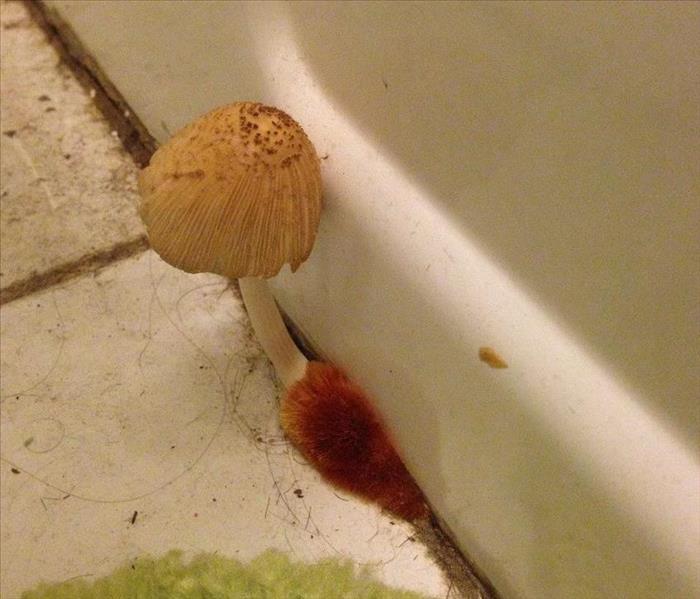 Mushrooms will grow with the right conditions. Please do not try to handle this yourself there is a bigger problem going on than just a mushroom
Mushrooms will grow with the right conditions. Please do not try to handle this yourself there is a bigger problem going on than just a mushroom
Mushrooms..
Many people like mushrooms and the vaiety and textures available are endless. That being said, from time to time we get calls that people have mushrooms are growing in their home. On a ceiling, out of a wall or floor. What is going on in the home that this is happening? We will dive into that a bit more and explain what conditions are needed for this to happen. One thing to know is that you do have an underlying problem and it is not going to be just as simple as getting rid of the mushrooms.
What is a mushroom? It is a variety of plant that grows in very specific conditions. Since it does not use chlorophyll to grow it actually does much better in darker environments. Even indirect light from a florescent lamp can do the trick. One key thing that they do need is moisture, a high humidity environment is always present. While too much water will kill them moist environments are ripe for growth. They tend to grow on decomposing materials such as trees, leaves, mulch, soil, compost wood. An ideal temperature for mushrooms is 70 degrees F but a wild mushroom with the right environment can grow in a range from 40 to 90 degrees F.
With that out of the way let us explore why that matters to you and your home. Do you have a basement, attic or crawl space? Do you have a bathroom that is used at all? Is there a toilet in your home that has water in it? You are halfway there to having the right environment for growth. Do you live in an area with humidity levels that are tracked by the local weatherman? Yikes you are getting closer. Does the interior of your home feel humid and sticky? Have you ever had a water leak that you cleaned up on your own? How is the pitch and grade of the water away from your home? Do you live in a flood zone or have had more rain than normal? Was there a flood on your street due to a pipe break or excessive rain? If you answered yes to any of these questions you could have the right environment for mushrooms in your home.
Let me first explain that if you see a mushroom in your home you have mold in the house somewhere. You also have water that is getting onto surfaces that you do not want it on. Should you see mushrooms you must immediately work on finding the water source. A slow drip pipe leak, a toilet whose seal has broken even just a little bit could be the reason. There could a number of reasons for the water intrusion. Just removing the mushroom will not alleviate the problem. Once you find the source of the water and stop it, you much assess the true damage. Follow the path from the water source to the mushroom.
Let us provide you with a real life example.
Toilet leak: Owner knew about the toilet leak: It dripped from the 2nd floor bathroom down into their dining room and into the basement. The owner initially elected to clean it up on their own. Wiping everything down and cleaning the walls and ceiling they thought were affected. The unfinished basement was nominal in their eyes and they threw some cat litter on the floor to absorb the water. Thinking all was fine they went about their lives. Days later the dining room ceiling had mushrooms growing from it. What the owners did not do was clean between the walls nor did they dry out the spaces between them. The contaminated water that was trapped between the walls provided a prime environment for the spores of the mushrooms to grow and spread out from the mold that had started to run along the wood beams. There was a great deal of work that needed to be done to open up the walls and decontaminate everything that the water had touched and spread to. Had a professional been called initially they could have opened smaller sections and reduced the damage. There is more to the story but the moral is just because you cannot see it does not mean it is not there.
There are steps you can take to reduce moisture in your home.
Keep bathrooms as dry as possible when done using it.
Wipe the inside of the shower down.
Keep all towels off the floor
Use mats at all major entrances and especially in shower and bathroom areas
Have a professional check all the pipes for leaks
Inspect the toilet for a proper seal.
Call a professional if you have a water intrusion in your home.
The most important part of seeing a mushroom in your home is knowing that you have something bigger going on. You have to accept this and know that it is not as easy as getting rid of the visible problem. Even if you call a professional it is important to trust what they are saying to you and not be solely driven by money there can be major consequences should you ignore or not properly treat a mold problem. Remember there are all sorts of tips and tricks online not all of them are accurate.
Bleach may work on the mushrooms in your home but they do not work on the mold. Where there is mushroom there is mold. Be sure you do your research and don’t try to tackle this problem on your own.
Mold: The Myth ; The Reality; The Solution
2/23/2017 (Permalink)
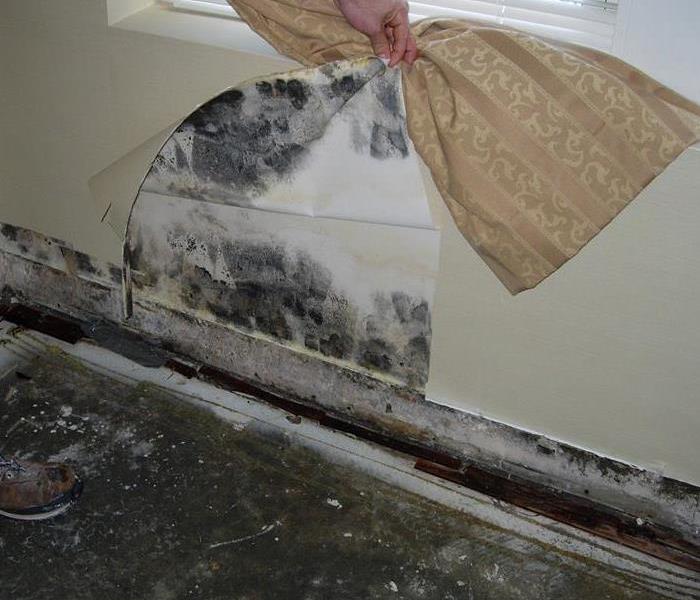 Great example of mold visibility and level of actual damage
Great example of mold visibility and level of actual damage
Mold is everywhere. Sorry to be the bearer of bad news. It is not always bad either. Many molds we embrace and some of us even eat as delicacies. Yeast, Mushrooms and Blue Cheese are great examples of molds we embrace and are widely consumed. In addition many are used in hospitals every day to fight and ward off infections such as Penicillin, Lovastatin, Clyclosprine and many more. We also find ourselves in contact with mold every time we go out. Most of this mold is harmless and does nothing to us. The damage lies in when we are in enclosed spaces with reduced circulation and a moist environment. There are specific types of mold that produce spores known as Mycotoxin these are the ones you do not really want around. That being said there are some myths about how to handle and clean this up should you find it within your home.
Let us take a look at the top 8 myths:
Mold is natural so you do not have to worry about it
If you only see a little bit of mold it is nothing to worry about it.
There should be no mold inside
All mold is bad
All mold causes health problems
Bleach Kills mold
Killing mold is enough I do not have to remove it
Cleaning up mold is not that hard you can do it yourself.
WOW ok that is a lot of information and very contradictory information at that. We have already debunked the idea that all molds are bad but what about the rest. While mold is a naturally occurring substance that does aid in decay it does not make it safe all the time. As we stated it is the type of mold that can be damaging not only to the air but also any building or area that it is found it. This is due to the way it feeds. It must absorb nutrients from the organism rather than directly eating it.
So when you can actually see the mold you have a much larger problem. Mold likes warm moist areas to live. All too often these are places you that go undisturbed for extended periods of time. When you can see the mold it is like an iceberg. The majority of it lives below the surface. When you open a container of fruit that was in the back of the refrigerator what you see is contained inside a sealed area. Your home attic, basement or forgotten closet is not quite as contained.
This is not to say that no mold should be inside a home at all. Mold is everywhere and all around you but acceptable levels and safe types of mold are the focus here. When an area is given ripe conditions for growing mold is where problems arise. Your health along with any allergies will determine how much mold you can tolerate within the environment. No one has set specific levels however within confined spaces vs outside our tolerance levels are drastically affected. There are a great number of contributing factors that come into play. Central heating and cooling for example allow for rapid air flow which can circulate spores faster as well create more air borne particles more likely to be breathed in than those that are not.
Having already determined that not all mold is bad, let us examine what happens to your health when you do come into contact with mold. First and foremost it does not mean you will get sick. Just like anything else there are varying degrees. Let us just say that you are very sensitive to the environment, already sick, or have severe allergies to other things. This could lead to a more intense reaction to mold spores. This does not mean a lack of a reaction means it is safe left un-treated it will continue to grow and can quickly become out of control.
So how do you get rid of it.. Bleach right… WRONG.. Understanding basic science helps here. Bleach is meant for topical treatments and does not soak into materials. Bleach is also very strong and can damage many surfaces that it comes into contact with. So anything porous gets a good cleaning from the surface could be ruined and you still have mold. Mold does not live on the surface of materials which we already discussed. It is a deep down organism. It needs the same to combat it. Concrobium ( Commercial grade) has these properties. It gets through the surface deep down into the materials. It then finds the mold spores and wraps itself around then and crushes them as it dries. While doing so the anti-microbial barrier remains on the surface to protect against future mold growth. Bleach dries and evaporates. Remember mold is under surfaces just like the iceberg.
Ok so I will go to the store and get some of that and I am all set right?? Well not exactly. Just wiping down a surface with the Concrobium will not do it. What caused the mold to grow in the first place. Did you use a scope and look behind the walls, get into the attic, or crawl space and see what was going on. Did you stop the problem? Did you remove the ruined insulation? What was the insulation rating, how thick was it and what did you do to replace it? How about that wall that is covered from the back? Were you able to get it all wiped and cleaned wait what about the front of the wall the pretty part? Did you spray and wash that down? What about the middle paint has a membrane that most moisture can not get through which is why you only saw it on the back of the wall. The middle of the wall though what did you do to access that! This is why you do not just wipe it down kill what you can see and move on.
Killing the spores that are there does not mean you still do not have a problem. If some of the spores were disturbed while you were spraying the solution and traveled outside of the treated area you will have this problem again. If too many of the spores became air borne they can get into vents and duct work and move to other areas of the house. Or even push down deeper into the materials affected and work from the other side that you may not have treated. Looking behind walls to determine the scope of the work needed is important. Many walls and beams can be affected and could need to be replaced. Calling a professional to assist in the proper remediation is the best way to get it taken care of properly.
Myths debunked. Check. Doctor visits are recommended if you suspect you have any issues that could stem from mold. Always call a professional and have them assess the situation before you try and handle it yourself. Be safe out there and makes sure you remember not all mold is bad.
Weekend flooding ..Cleaning on your own !!!
1/31/2017 (Permalink)
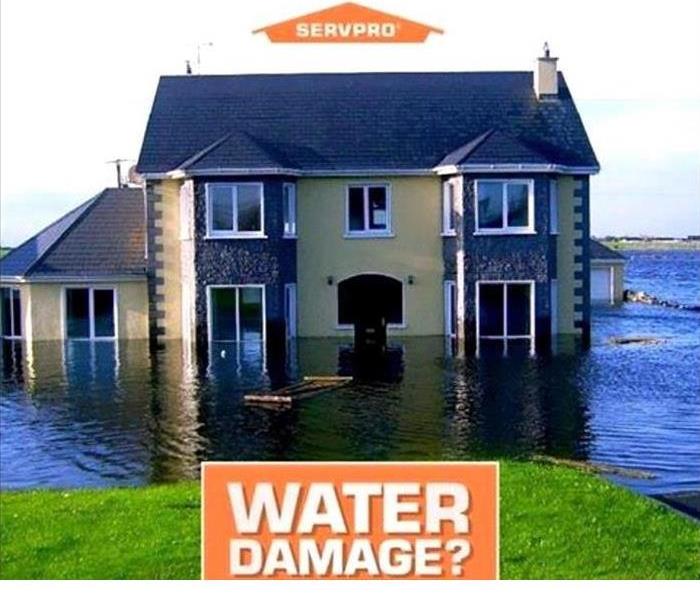 Water damage does not have to be this severe to be a problem. Cleaning it up yourself can be?
Water damage does not have to be this severe to be a problem. Cleaning it up yourself can be?
Over the weekend I heard a lot of people talking about getting flooded. When prompted about who they had come out and clean the water they most assuredly said they did it themselves. Below you will find what was done by the majority of people.
Step 1: Went out and bought a wet/dry vacuum.
Step 2: Get rid of water. Used a lot of rags, towels, New Vacuum
Step 3: Go through all the stuff that was wet repack what they thought could be saved and tossed out what was too wet.
Step 4: Found their home dehumidifier in the closet and placed it in the room. Left it on for a few hours and then turned it off.
Proudly showing off that there was no longer water in their basement and how they solved the problem.
YIKES>>>>>>>>>>> Few Steps missing
Step 4: has a lot more than setting up a dehumidifier for a few hours. Industrial dehumidifiers are set up in homes and left on for at least 3 days. They are also set up with industrial fans that circulate the air and blow directly on the wet materials so that they will dry faster. No fans were set up and the dehumidifier was not left on for nearly long enough.
Step 5: Take moisture readings after a few days to asses effectiveness of the drying process outlined above. If readings are not back to normal levels for the home you need more time to dry.
Step 6: Spray everything. Concrobium is an anti-mold growth spray that must be used to cover everything that was wet. Floors, walls, Appliances, any wood or furniture that was wet with the damage must be sprayed. This step is crucial to not get a musty smell in your home. That smell is a result of improperly drying from water damage.
Should you notice mold you must call a professional. Mold remediation is a much more intensive process and is a lot more costly. If you recently cleaned up a water damage problem yourself and skipped any steps above I suggest you call a professional to have them properly assess your situation. It only takes 24 hours for mold to start to grow. The water that you cannot see causes the most damage. Please make sure you are working with a professional when there is damage this can save you thousands down the road.
Mold Testing Yes we do that too!!!
7/8/2016 (Permalink)
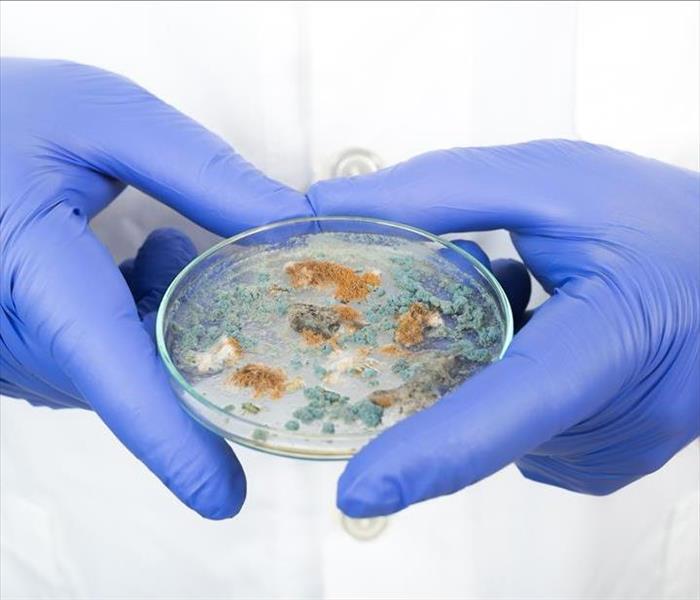 Mold testing can make all the difference in your home... Get yours done today
Mold testing can make all the difference in your home... Get yours done today
Mold Testing
When to have an indoor air quality test done, and how the test is done. The word mold is not as bad as everyone thinks it is. The only time it becomes a problem is when there is too much of it. Too much mold can cause health problems or damage to your property. Not every home needs testing and not all testing is the same.
What sort of things should you be on the look for to decide if you need any mold testing.
Any general concerns about the house where something just does not seem right and you cannot put your finger on it.
When a home has been empty with no occupants for an extended period of time
Past water damage that was not cleaned up by a professional or you suspect was not done properly
No home inspections have been done in a while you see or suspect there is mold somewhere
A musty smell that is notice upon entering the home
Anyone in the home that has repertory problems
Mold Remediation was done and you want to ensure it was effective.
Visually seeing anything that looks like mold
If mold removal or clean up was done
When a 3rd party is effecting repairs and you need to make sure they are done correctly
There are 3 main options for testing
Surface Testing
This is done to look for evidence of actual current or past mold growth. The tester will use either a swab or a tape lift to obtain their sample. These tests can tell if the growth is from actual water damage and intrusion or if it is excessively humid in the home. Dark and discolored growth is not always microbial and would mean it is not from a water damage situation. When you see visual growth it is always important to get a sample of it as well as an air quality sample to ensure spores have not been released into the air.
Indoor air quality testing
This is done by taking numerous samples from within the inside of the home as well as a base line sample of the air quality on the outside of the home. These samples will be able to tell if you have hidden moisture leaks.
Indoor Air Quality with Comprehensive moisture evaluation.
This testing is done to provide a full scope picture of what is really going on in the home. It is able to locate sources of moisture that overtime could damage the property or become a health concern. Mold and moisture damage can drastically affect the value of a home over time. So it is important to stay on top of things and help prevent any major damage. Identifying the damage early can save you in the long run.
Remember when you have any doubts or questions about mold in your home talk to a professional get your results and get it right the first time.
It is Spring Time... Spring Cleaning musts to stay healthy
5/10/2016 (Permalink)
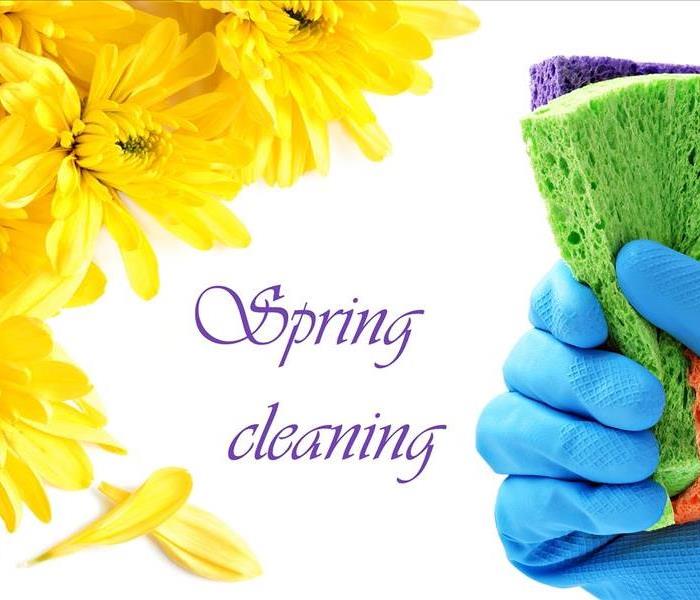 Spring Cleaning... Rid your home of mold
Spring Cleaning... Rid your home of mold
It is spring time… The flowers are opening, trees are blooming, birds are chirping and you want to open your home. Refresh the air that has been cooped up all winter long with little to no circulation. Your home still smells funny. Well with the spring comes spring cleaning. This cleaning is a deep down get into places you may never have. Because once summer comes those air conditioners are going in and your house will be shut up tight keeping the hot air out.
Washing Machines
So over the holidays you got a fancy new washing machine. One of those front loaders that holds that queen sized comforter so you no longer have to go the laundry mat once a week or month because you put it off. Or the one you got because the sensor on your old one did not sense when it was fully and your laundry room and basement were flooded beyond reproach. That is wonderful and it has been working like a charm but what in the world is that smell coming from the inside of it . You clean it with laundry detergent 5-6 times a week why on earth does it have an odor. The gasket and the glass that your cat marvels at as your clothes tumble around stay wet. The door is usually closed when you are not using it so the gasket and the glass stay wet. Coupled with the pieces of lint that fell off while the laundry was in there makes a perfect breeding ground for mold. We suggest wiping the gasket inside and out weekly and giving your machine a once over with bleach and no clothes. This will kill any of the bacteria that could be growing inside the crevasses.
Refrigerator
Yes you know that place you use day in and day out for your family meals, the on the go rush out the door grab the apple place. There is a tray underneath it that will sit and collect condensation for you so that your floor is not ruined. Guess what, it collects condensation which is a fancy term for water. That water sits for weeks, months maybe years on end because you did not know it was there. Particles of food and dust get pushed into it when you sweep and it all starts to do what nature does best. GROW.. You mat not smell it right away or at all but trust us it is there. We have seen it at our own homes, yes even we get busy. Make cleaning the drip pans part of your spring cleaning. Natural cleaning solutions work best our suggestion would be to mix hydrogen peroxide in a cup of water and spray the pan thoroughly. Take a rag and soak it in white vinegar and wipe clean. Make sure you are cleaning the floor around the pan as well leaving nothing to chance. Once a year should do the trick.
Dishes
Yes your dishes can become moldy. What tends to happen is you ask your kids to help you and they “DRY” the dishes and they get put away in the cabinets. The water that is still left on them drips onto the shelving and sits there. Especially on holidays with dishes that are not used very often. Many times the water will stay on the dish in the bottom and just festers there until they are used again. If it is the shelving that gets wet, it goes un-noticed as many times it is over head. Ways to prevent this is to make sure dishes are fully dried before they are put away. Should you run into mold we suggest you clean all dishes in the cabinet and wipe the shoveling down with a wet rag soaked in vinegar and let dry thoroughly before you put everything away.
Air Conditioners.
Ok so the spring air has turned to the heat of summer and you want to start up that air conditioner. Before you do it is advised you clean it through and through. Air conditioning units are made to trap pollen and dust along with moisture from the air. All of which is the food and water mold needs to grow. In as little as 24 hours in warm weather mold can start to grow and if you have a central air conditioning unit and you suspect mold you must call a mold remediation company to clean the duct work, drain pans and coils. Should you have a window unit remove the front panels, flush the drain pan and the coils with a 1:1 bleach to water ration and, use a HEPA vacuum to clean out the blower.
No matter what you have on your agenda for this spring and summer make sure you start off on the right foot by staying safe and clean. Should you have any question about things you find in your home never take chances call a mold remediation company to review your problem and provide you with the expert advice to make it like it never even happened
MOLD IN YOUR COFFEE..MOLD IN YOUR COFFEE..THERE'S NO WAY..BET YOU THINK THIS ISNT ABOUT YOU..THERE'S NO WAY.. ( you know you sang that) But Seriousl
1/21/2016 (Permalink)
 Mold in your coffee..YIKES!!!!! it looks so happy and make me function How does it have mold.
Mold in your coffee..YIKES!!!!! it looks so happy and make me function How does it have mold.
Your clean you wipe and wash your kitchen, keep your dishes done run hot water through your coffee machine from time to time. What are you talking about there is mold in my coffee???? A study done by National Science Foundation (NSF) found that the largest concentration of germs is located ( no not the bathroom) but in the kitchen. Guess what the top 10 dirtest items are Kitchen sponges, Kitchen Sink, Toothbrush Holder, Pet Bowl, COFFEE RESEVIOR, Faucet Handles, Pet toys, Countertops, Stove knobs, and Cutting boards..
See that nestled right in between pet bowls and faucet handles.. COFFEE RESEVIOR…A pets bowl is cleaner than your coffee resevior?? Inside half these reservoirs they found mold and yeast. A staggering 10% have been exposed to Coliform Bacteria. WHAT IN THE WORLD. In your coffee.
Ok so how is that even possible?
I run hot water through my machine to make the coffee. I also thought coffee had antibacterial properties to it. Should those two things be enough to keep the bacteria and mold at bay? Nope not even close for water to work it needs to be boiling NO coffee maker gets water to reach its boiling point. You would sue them for getting burned all the time. The acid in coffee only works on about half of the germs that are found in the pot and filter. If anything the warm moist environment makes it the perfect breeding ground for the bacteria and mold.
Another thing is the our bodies are great at adapting. We build up a resistance to these germs that are ingested in small amounts over the course of time. When ingesting a potentially harmful organisim our body does have the ability to filter out some of the infected particles. This is not ideal because the germs too adapt and can slip by your immune system eventually and make you sick.
Ok so how to clean the Coffee Maker:
The frequency is commensurate with how often you use your machine. If you use it for a pot per day I would suggest a through cleaning once a week. If you have a machine that gets more use like a communal one at work a few times a week would be advised.
Any parts of the coffee machine that can be removed should be for effective cleaning. This includes but is not limited to carafe if there is one, the basket that houses the filter and coffee itself, any parts of the machine that can be removed easily. Make sure you use hot soapy water to eliminate germs, stains, and residue oils left over from making the coffee. Once this is done make sure everything is fully dry before you put your machine all back together.
Great your done right? No one more step
Your water no matter how hot or soapy will leave behind elements that can encourage growth because there are minerals in the water. This will have to be removed. Because you drink from this machine it is suggested that you leave the chemicals behind and settle for some natural products. The suggestion is using a vinegar based solution at a minimum of once a month. This will decalcify the machine and produce a better cup of coffee.
Here the suggested way to get that done. Fill the water reservoir with half water and half vinegar… Pretend you are going to brew a pot of coffee and put the filter in where you normally would. **DO NOT PUT COFFEE IN IT** Brew this until almost half of the water has emptied into the pot turn off the machine. Walk away and leave everything for about a half an hour. Turn the machine back on and finish the brewing process. Once this is done remove the filter and just run some plain water through the machine. I would advise doing this two times to make sure the vinegar is fully out of the machine. Then do one more rinse of the hot soapy water that is being done once a week. This will ensure the bacteria and mold are not able to grow and make you sick.
The machine is clean and there is no more mold in your coffee. This should allow you to enjoy that cup of coffee the way it was meant to be enjoyed worry free……. Happy sipping
GOT MOLD???? LET US KNOW
1/12/2016 (Permalink)
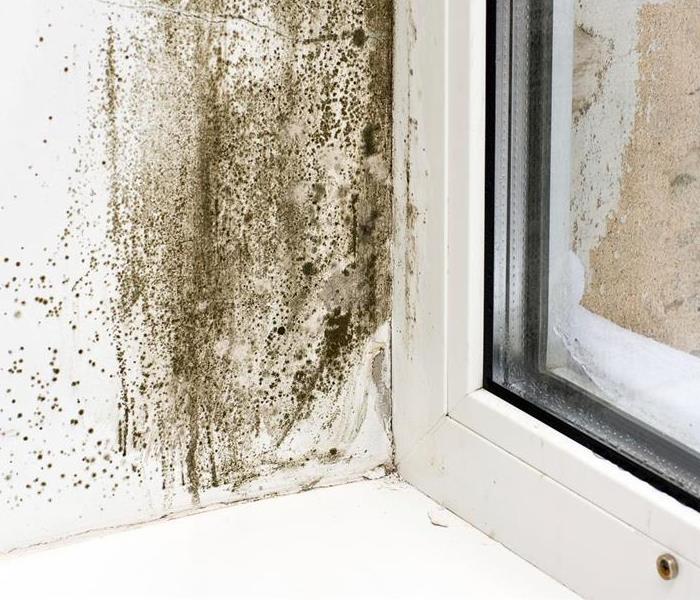 Mold can appear in more than just bathrooms Take a look around.
Mold can appear in more than just bathrooms Take a look around.
Mold remediation
Did you know there a lot of different kinds of mold, while some of the names may be foreign you may find that they are more common than you thought. If you have any doubts about the conditions in your home please make sure you call a professional. They have the testing equipment and the certified knowledge of how to get rid of any potential issues properly.
Just because you cannot see something does not mean it is not there so use all of your senses and trust your instincts. Check out where these types of molds can hide and take a look around.
Stachybotys
These stachybotrys molds grow on high cellulose material such as wood, wicker, hay, paper and cardboard. They are also commonly called ‘black mold’ and sometimes ‘toxic black mold’. This mold requires very wet or high humid conditions for days or weeks in order to grow.
Aspergillus
Aspergillus is the most common household mold. There are over 185 species of Aspergillus and 22 species are known to cause human illness. They can be found in almost any home or office on damp walls, wallpaper, PVC/paper wall covering, gypsum board, floor, carpet and mattress dust, upholstered-furniture dust, acrylic paint, leather, HVAC insulations, filters and fans, humidifier water, shoes, leather, bird droppings and potted plant soil, plastic and decomposing wood.
Cladosporium
Over 30 species of Cladosporium Species some produce olive-green to brown or black colonies, and have dark-pigmented conidia that are formed in simple or branching chains. They can be found on living and dead plant material but may grow on surfaces when moisture is present
Mucor
Common in soils these mucor molds are also often found along air conditioning systems and ducting. They are fast-growing, whitish to greyish, with usually thick growth.
Penicillin
Penicillin you may know as the miracle medicine but the penicillin mold can grow in your home on both walls and on a forgotten sandwich. Commonly found in soil, food, grains, paint, carpet, wallpaper, interior fiberglass duct insulation, and rotting vegetation.
Fusarium
Is a common soil fungus. It is found on a variety of plants as well as humidifiers.
If you think that you have any thing that resembles any of the above descriptions please make sure that you call someone to have it checked out. So that any potential problems do not get worse or cause a larger more severe problem later down the road.
 SERVPRO of East Boston, Chelsea, & Revere is an area leader in mold remediation services, call us today to learn more.
SERVPRO of East Boston, Chelsea, & Revere is an area leader in mold remediation services, call us today to learn more.




 24/7 Emergency Service
24/7 Emergency Service







